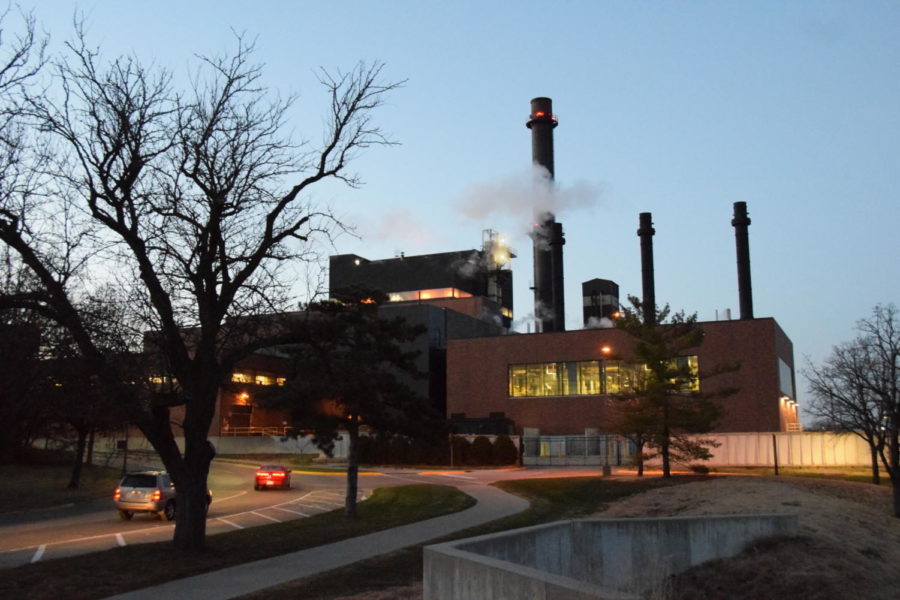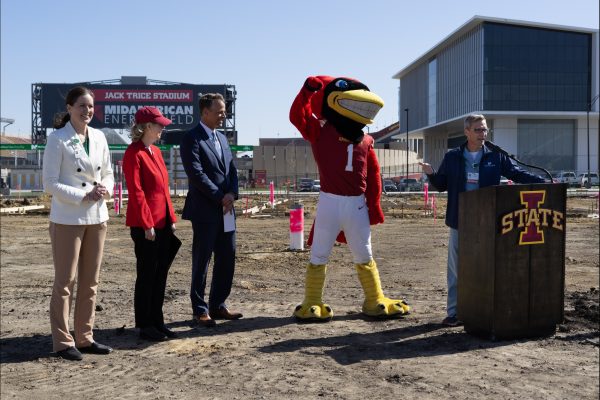Iowa State facing the future of powering campus
Iowa State’s power plant has been operating on campus since 1884.
The Iowa State University Power Plant is in the process of updating its fourth of five boilers to run on natural gas rather than coal in an effort to reduce greenhouse gas emissions by 50% before 2025.
Director of Facilities Planning and Management, Mark Kruse, said with the updated boilers, they will have reached their goal by April. Kruse said many people call natural gas a transition gas, treating it as a stepping stone to a renewable future.
“Electricity, we generate about 52% with our turbines,” Kruse said. “The rest we purchase. We’re a member of the Midcontinent Independent System Operator, which is essentially the electrical grid. We partnered with the city of Ames, so we purchase right off the grid at wholesale prices.”
Iowa State’s power plant is a co-generation plant, meaning high-pressure steam is used to power turbines and generate electricity, while the excess is sent around campus to heat buildings. Kruse said that 50% of the energy Iowa State uses goes towards heating buildings.
Cheyenne Minniss, a senior in mechanical engineering and president of the Climate Reality Campus Corps, said Iowa State could be more aggressive when it comes to its commitment to sustainability and reducing environmental impacts.
“I don’t think that their current sustainability plans or even their current sustainability initiatives on campus really reflect the urgency that climate change has associated with it, like the effects of climate change,” Minniss said.
Iowa State also has purchase agreements with the wind farm north of Ames and purchases about 37% of the output from the solar farm by Highway 30. Kruse said this means all of the energy purchased by Iowa State is renewable; the rest is generated in-house.
“With coal modifications, we’re reducing our greenhouse gas emissions by 35%,” Kruse said, “and we’re gonna be able to pay off that project in four years due to less maintenance, less staff and fuel prices.”
The other 15% of emission reductions come from Iowa State purchasing renewable energy credits along with the electricity they buy off the grid.
“And then we buy renewable energy credits tied to that which basically gives us the title to the renewable attribute of electricity,” Kruse said. “So, we essentially buy that renewable attribute from solar farms, wind farms, things like that to claim our vested title to that green electricity.”
Minniss criticized the fact that the 50% reduction in emissions is partially due to Iowa State purchasing renewable energy credits.
“Lots of experts in the field will say that renewable energy credits are just economic loopholes, and I tend to agree with those viewpoints,” Minniss said.
Regardless of the effectiveness of the renewable energy credits, Minniss said that the reduction of emissions from the power plant is not enough, as the campus still depends on fossil fuels for energy.
“That is the core issue here,” Minniss said. “Our dependence on fossil fuels is what is causing us to emit hundreds of thousands of metric tons of carbon dioxide into the atmosphere.”
Obtaining natural gas can have detrimental effects on both the environment and people in communities near where natural gas is harvested, Minniss said. Although natural gas is looked at as a stepping stone to more sustainable options, Minniss said the energy source has negative impacts outside of strictly environmental contexts.
“It may be a stepping stone solution to get us to bridge the gap between clean energy, but then the people that have to pay that price are the people of color and poor communities that are forced to be subjected to fracking communities,” Minniss said. “They have to deal with the earthquakes; they have to deal with arsenic in their water; they have to deal with benzene in their air.”
Kruse said that Iowa State is starting a study to look into potential options for renewable energy. Some of the options include geothermal, renewable natural gas and solar or wind energy.
Minniss said that the power plant began their study because of actions taken by the Cimate Reality Campus Corps. Minniss said it just goes to show that students can enact change on campus and that students should always speak up for what they believe in.
Yuyu Zhou, associate professor in geological and atmospheric sciences, said natural gas is a step in the right direction for producing cleaner energy.
“I think this is a good direction, not just to local or even Iowa, but even global,” Zhou said. “We’re facing the potential warming climate, and the reduction of the emissions is definitely a key. So, we need to keep the temperature in the 1.5-degree increase, so we don’t have much time.”
Zhou said he was happy to see Iowa State’s efforts to reduce emissions by switching from coal to natural gas. Zhou also said it’s important to research the various options available and their potential impacts before moving to a solution.
The utility industry today is at an inflection point, where they must decide on a new means of generating energy, Kruse said. Over the past 150 years the industry has relied on fossil fuels, but moving forward they must find other options with less environmental impacts.
Kruse said reducing the first 50% of Iowa State’s emissions came relatively easy, as renewable energy credits are cheap and the boiler modifications will pay for themselves after four years. The next step is significantly less certain, as Iowa State is looking into new options for generating energy.
Minniss said while Iowa State assesses options and researches paths to sustainability, people continue to be forced to deal with the effects of fossil fuel consumption. Minniss said Iowa State should be pioneering the sustainable options available, rather than looking to other schools to set an example.
“I think that we’re smart enough. We have enough people on this campus, passionate engineers, professors, researchers, that we can make the solution happen,” Minniss said. “It’s not really a matter of, ‘Oh, we don’t know what to do. We don’t know what technology is available.’ There are several options. I would say we simply need to do something and make it work and not wait for other schools.”
One idea that Minniss proposed was to invest in a combination of wind and solar generation, as well as some form of battery or thermal storage. Minniss said that these sources fit great with Iowa’s climate and that thermal storage would work well with Iowa State’s Cogeneration infrastructure.
Zhou said renewable technologies like wind and solar power are important, but it is necessary to look into the potential negative impacts of such technologies, for example, the resources that go into producing them.
“If we want to build a large area solar panel, first there’s the material,” Zhou said. “To produce the solar panel materials, we need energy, right? Normally it’ll take like one to four years for this solar panel to generate the energy to cover the energy to produce these materials. But fortunately, the solar panel could last up to 30 years.”
Technologies like solar farms can have negative impacts on habitats or wildlife, but these can still be mitigated by thoughtful planning of how such technologies can be integrated into different environments, Zhou added.
Although Iowa State does have a wind turbine on campus generating electricity, Kruse said that it is the campus’s highest cost of electricity and that when the agreement on the wind turbine expires, Iowa State will likely not renew the agreement.
“We can buy it on the grid, renewable electricity, for half [the price],” Kruse said. “So, for the same outcome with carbon emissions, we can better purchase renewable electricity than try to put up wind or solar.”
Kruse said using renewable energy technologies is mostly only financially feasible when done at a large scale by a private organization.
“The city of Ames is looking at adding more wind and solar, and they’ve identified the same thing that they have to deal with a private partner,” Kruse said. “It’s tax credits and stuff to make it more affordable versus doing it themselves.”
It’s hard to compare generating renewable energy in-house to purchasing it from the grid because of the upfront investment in infrastructure and the lifespan of the technologies, Zhou said In the short term, it makes more sense to buy from the grid, but taking into account the 20-30 year lifespan of solar or wind energy may tell a different story.
Kruse pointed out that investing in renewable electricity generation also means investing in electric infrastructure for transportation and storing electricity.
“In talking with industry and our utility companies, we’re probably at 15% penetration of renewable energy at this point in time,” Kruse said. “By the time you get to 25%, there’s gonna have to be billions of dollars of upgrades to it, just for reliability and regulatory maintaining voltage levels, stability and things like that.”
Kruse said developing the necessary infrastructure is a very slow process. From the time they begin thinking about building a transmission line, it can take 10 years to plan the project, get regulatory approvals and the landowner’s permission and carry out the project.
“And with that, we’re at that inflection point. Can we become more sustainable? Can we get closer to carbon neutrality? Sure,” Kruse said. “But how do we do that while being good financial stewards and not pricing everybody out of a college education at the same time,”
A lot of it comes down to conservation and efficiency. Kruse said it takes everybody to be conscious and frugal with their energy use to make a difference.
“It comes down to something as simple as turning off the light switch when you walk out of your dorm room or out of the classroom,” Kruse said. “Things like that, that all adds up.”
Your donation will support the student journalists of the Iowa State Daily. Your contribution will allow us to purchase equipment, send our student journalists to conferences and off-set their cost of living so they can continue to do best-in-the-nation work at the Iowa State Daily.











